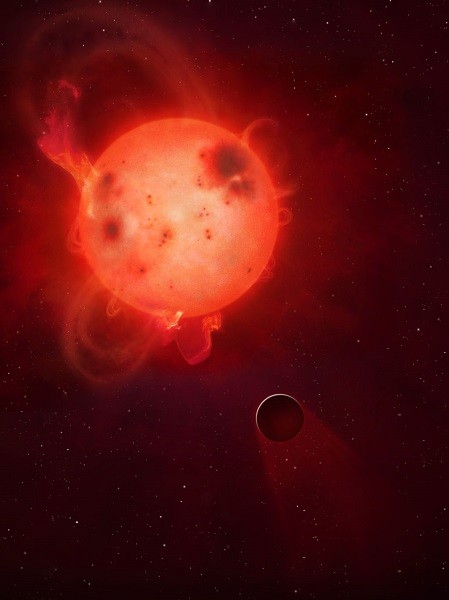Powerful Radiation Blasts Make Most Earth-like Planet Not So Habitable Anymore
| Ana Verayo | | Nov 18, 2015 06:50 AM EST |
(Photo : Mark A. Garlick/University of Warwick) Radiation blasts make Kepler 438b, which is the most Earth-like planet, no longer habitable.
Scientists have considered Kepler 438b as the most Earth-like and habitable planet ever found in the solar system, however this distant world apparently may seem not so hospitable anymore with new research regarding powerful radiation blasts.
Like Us on Facebook
Since astronomers from the Harvard-Smithsonian Center for Astrophysics discovered this exoplanet with the aid of the Kepler Space Telescope in January this year, they also revealed that this small, rocky world that has been orbiting its host star Kepler 438, is almost the size of Earth and its orbit is an ideal distance from its star that can be conducive for liquid water, making it not too hot, to produce life.
Now, astronomers from the University of Warwick say otherwise, where they believe that this would-be hospitable planet that could potentially hold life is apparently deadly for micro organisms to thrive. New findings reveal how the surface of exoplanet Kepler 438b is blasted regularly with space radiation that can destroy its already tenuous atmosphere, making the planet lifeless.
According to astrophysicist David Armstrong, unlike the sun in our solar system, the star Kepler 438 is streaming extremely powerful flares every hundred days or so where each one is measured to be stronger than the sun's most powerful solar flare ever recorded. These flares can also be linked to coronal mass ejections that can damage and destroy any traces of life on the exoplanet.
He adds that if Kepler 438b did possess a magnetic field similar to Earth's, then the planet could have been protected from these radiation effects. However, if a magnetic field is still too weak to shield from these flares, the planet could risk losing its atmosphere where the surface will become irradiated with extreme UV and X-ray radiation, making life impossible to exist.
Kepler 438 is considered as a red dwarf star that emits superflares with energies of 100bn megatons of dynamite that are released every few hundred days. Scientists also believe that its coronal mass injections that are connected with the flares are more destructive for life to thrive on the alien world.
According to researcher Chloe Pugh, when a coronal mass ejection erupts, this will increase the occurrence of more powerful flares and larger coronal mass ejections can strip away the atmosphere or any of it that's left of Kepler 438b, making it an uninhabitable world. Also, average temperatures on Kepler 438b reach at 60 degrees Celsius.
This new study is published in the journal, Monthly Notices of the Royal Astronomical Society.
TagsKepler-438b, most habitable earth like planet, exoplanet, earth-like planet, most earth like planet, habitable planet, hospitable planet, superflares habitable exoplanet, most habitable earth like planet too radioactive
©2015 Chinatopix All rights reserved. Do not reproduce without permission
EDITOR'S PICKS
-

Did the Trump administration just announce plans for a trade war with ‘hostile’ China and Russia?
-

US Senate passes Taiwan travel bill slammed by China
-

As Yan Sihong’s family grieves, here are other Chinese students who went missing abroad. Some have never been found
-

Beijing blasts Western critics who ‘smear China’ with the term sharp power
-

China Envoy Seeks to Defuse Tensions With U.S. as a Trade War Brews
-

Singapore's Deputy PM Provides Bitcoin Vote of Confidence Amid China's Blanket Bans
-

China warns investors over risks in overseas virtual currency trading
-

Chinese government most trustworthy: survey
-

Kashima Antlers On Course For Back-To-Back Titles
MOST POPULAR
LATEST NEWS
Zhou Yongkang: China's Former Security Chief Sentenced to Life in Prison

China's former Chief of the Ministry of Public Security, Zhou Yongkang, has been given a life sentence after he was found guilty of abusing his office, bribery and deliberately ... Full Article
TRENDING STORY

China Pork Prices Expected to Stabilize As The Supplies Recover

Elephone P9000 Smartphone is now on Sale on Amazon India

There's a Big Chance Cliffhangers Won't Still Be Resolved When Grey's Anatomy Season 13 Returns

Supreme Court Ruled on Samsung vs Apple Dispute for Patent Infringement

Microsoft Surface Pro 5 Rumors and Release Date: What is the Latest?










